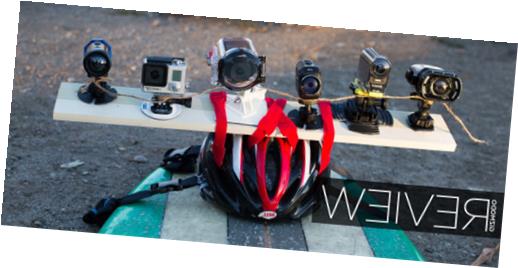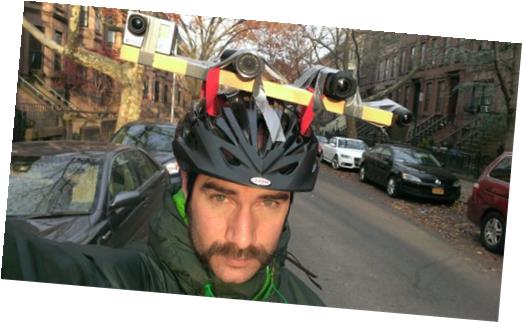
|
|
  |
|
17 Ноя. 2014 г.Экшн камера тестFor many professional and amateur photographers, GoPro changed the way they captured action shots, especially automotive action. But some stuff doesn't come through as clearly as it does when uncompressed on a nice display.You can't just do something dangerous and insane these days without filming it for posterity. If I hadn't tied it to the other two cameras with string, it would be at the bottom of the Atlantic right now. All four of the so-called action cameras we’ve tested on the following pages record video in 1080p resolution, offer some level of water resistance, and are made to withstand a few bumps without disintegrating. The battery life was second only to the Drift, coming in at a very respectable two hours and 37 minutes. Tape!GoPro, now a company with $500 million in annual revenues, changed everything with the debut of its first rugged camera in 2007. For example, the record button is tiny and looks just like the other three buttons, making it difficult to find, and the rear panel is actually really hard to open. Pros will appreciate the option to record raw video at a high bitrate, which allows serious post-production tweaking. So PopMech gathered and tested 10 of the newest action cams to check out the latest equipment that will capture future YouTube-worthy stunts, crashes, and other "hey, watch this!" moments. When I took it surfing, first there was a mysterious card error, so no footage was captured. Redesigned optics make the image quality a lot better than the noise-fest that it once was. You can choose from a ton of options on resolution, frame rates, burst speed, time-lapse rate, and more. Unfortunately, the one thing that could have really set the Ion apart from the pack is also where it stumbled. It supposedly has the same 170° viewing angle as the others, but it actually looks much wider. It's worth noting that while there are six cameras and we had to rank them one through six, none of these objectively suck. It's the only one of the cameras that can zoom, but it's digital zoom, so you're best to avoid it. It has a ton of options (including video tagging, and using the Drift as a looping dash-cam), and maybe it's just what you're looking for. Best of all, its battery life was easily the winner, coming in at two hours 46 minutes in our 1080p rundown test. At 5.55 ounces, it's very heavy, and its weight causes it to wobble in an elastic head-strap. So, in addition to spending time with each camera individually (usually using a head-strap mount), I built an ugly but effective rig for shooting with all six at once. Also, you have to use the app from your phone or computer to adjust settings or know how much space you have left on your card. And while action cameras let us relieve these life-highlights over and over, they aren't all created equal. From smartphones to digital cameras, the world is awash in video-capturing devices that will document your particular brand of hoonage. GoPros mounted with ease and, unlike complex DSLR rigs, didn't put an expensive camera at risk. Using the app (or one on your computer) you have a high level of control over the camera, including exposure, contrast, sharpness, and metering point. Not only can it shoot 720p at 120fps like the Sony, but it's the only one that has the horsepower to shoot 1080p at 60fps, for full-frame slow motion. It can do 720p at 60fps for half speed slow-motion (when played back at 30 fps), but that's only half what the GoPro and Sony can do. It's also built like a tank, has a threaded hole for tripod mounting, and a simple one-switch design. As far as usability, doing anything other than toggling between two preset modes requires you to connect to your computer or a smartphone app. It seems to adjust for the brightest thing in the frame, and everything else gets pushed down. All that said, if you're going to be shooting long, and only in bright daylight, and audio either isn't important or you're willing to use an external mic (there is a jack), this is still worth considering. We didn't notice while we were shooting (roughly an hour after surfing), but clearly some water had gotten in and was fogging up the lens. The Hero 3 can flip its image on the horizontal access, but the lens doesn't rotate, so you can't adjust to off angles. NOTE: We installed a firmware update for the Garmin Virb right before we went out to shoot the video above. Wi-Fi is built in, and while the smartphone apps aren't yet ready for the Black Edition, the included Wi-Fi remote control works extremely well from as far as 60 feet away. I packed the helmet full of bubble-wrap, taped the padding in, then used nylon tie-downs to attach the rig to the nose of a nine-foot surfboard. Everybody loves a scrappy underdog, and this one had all of the specs of the big boys at a competitive price: 1080p shooting at 60 frames per second, 12MP stills, Wi-Fi for pairing with a smart phone, and even a new, custom-built lens. It has a built in LCD screen (doesn't show images) and three buttons for scrolling through settings. Aside from being the biggest and heaviest (not fun to wear on your head) camera we tested there are a lot of little annoying details. Most of those can be selected on the camera itself using the LCD screen (which doesn't display images). We strapped three to a surfboard (the Drift wasn't yet announced) and surfed the leading edge of Hurricane Sandy. It comes with a handy two-way remote control that can be strapped to your wrist for easy starting and stopping, there's a two-inch TFT color screen and four physical buttons for easy menu navigation.  That's third place—the Contour was 32 minutes better, and the Drift was almost twice as good. There are a wide variety of mounts available, and it is the only camera in the group with built-in GPS. Smartphone apps are not yet available, nor are some accessories, like the waterproof housing that will let it go down to 180 feet. Directly after surfing, I strapped the camera to my head and went for a trail ride in the Santa Monica Mountains. Its battery lasted a respectable two hours and 10 minutes in our rundown test, good enough for fourth place. Picture ThisPicture ThisIt seems crazy today that just a decade ago, people were still recording outdoor adventures on tape. The Ion Air Pro 3 is supposed to be fully waterproof to an impressive 49 feet without the use of any additional cases. There is a time-lapse mode, but no burst mode, and fewer frame-rate options for video than the others. Part of the Contour's beauty is its simplicity: You flip the big switch forward, and it's on and recording. Using image stabilization or one of the higher frame rates also crops the image to a narrower 120° angle. You can't use the 170-degree wide-ange if you're shooting at 1080p—you're limited to 120 degrees—which is crazy. We were split on 3rd or 4th place for the Drift, but ultimately it was edged-out by a camera that had slightly better image quality and cost significantly less. It's the only one that has an image stabilization option, and while it significantly degraded video quality, it might be worth it in really bumpy situations. Speaking of, while we love how tweakable it is, there are so many settings that flipping through them with the camera's two buttons is a pain in the ass. At one point the rear cover become completely stuck on the device and we couldn't open it up to charge it or rescue the SD card. Despite the fact that all the cameras were shooting simultaneously, the GoPro looks like it was at shot dusk. Also, they have improved but somehow not completely fixed that high-pitched shrieking tone in the audio. There isn't much noise in low-light shots, but that's because the images are so dark you can't really see anything. It has built-in Wi-Fi, and the iPhone and Android apps work very well with it, as long as you're within 20 feet or so. You can't rotate the lens at all, which means you can only mount it straight up and down, and the rounded bottom means it can't stand up without a mount (few of which are included in the box). Considering that I was only paddling around for about 15 minutes in very weak surf, this doesn't give us confidence that it would make it to anywhere near 49 feet, though it's possible we just had a defective unit. The apps (for smartphones and desktop) were not yet updated for the Black Edition, so we couldn't get into the minute details (for exposure, contrast, etc) which aren't available on the camera. In our evaluations we weighted image quality most heavily, but we also factored in versatility, ease-of-use, form-factor, battery-life, apps, available mounts, as well as extras and price. The GoPro HD Hero became an important tool that supplemented traditional DSLRs already in the camera bag.GoPro continues to lead the action-camera market in sales, and we look forward to testing their newest top-of-the-line Hero 3 Black, which can record in stunning 4k. And it's waterproof to nine feet without a case, which is likely enough for a large number of users (it survived for half an hour at eight feet without any issues). This can probably be fixed in a firmware update, but even with these features working, it isn't nearly as detailed as the GoPro's remote. Bear in mind when you watch the above video that there is some quality lost to compression for internet streaming. The Hero 3 is the smallest and lightest of the group, making it easily the most comfortable to wear. While image quality is decidedly better than previous Drift models, the Ghost-S is still noticeably muddier than our top finishers. The raw video footage was evaluated on a professionally calibrated monitor, as well as on a 46-inch 1080p Samsung LED TV, and several laptops. Once again, the Drift absolutely crushed everybody in the battery rundown test, coming in at a whopping 3 hours and 14 minutes. I then attached the board to an old bike helmet using velcro straps, and actually got it tight enough that there was virtually no wobble. At 5.95 ounces, it's the heaviest of the group, which makes strapping it to your head rather awkward. While you can pan it side to side, the mounting system doesn't allow for vertical tilt adjustments. And then I strapped all four to my helmet and biked around Brooklyn (that rig, plus the Movember 'stache, elicited a lot of weird looks). A two-inch screen under Gorilla Glass makes framing shots and adjusting settings much easier, plus you can instantly review and trim your footage, which is a nice feature. Colors are generally very accurate, and it handles contrast pretty well, but image quality just isn't what it should be. The image quality looked pretty good in bright daylight (before the camera leaked), but the low-light shots are a noisy mess, and the audio is pretty lousy as well. For starters, when a mount snapped while skateboarding in our original review, we figured it was probably a fluke—but the same thing happened when I was surfing. It seems to be ramping up the ISO like crazy, but everything is so noisy and distorted it doesn't really matter that it's brighter. An optional looping feature can store video in a temporary cache—if you're on a long ride, and something unexpected happens that you want to save, you tag it, and only that moment is recorded.  |

 Gopro 3 black характеристики
Gopro 3 black характеристики